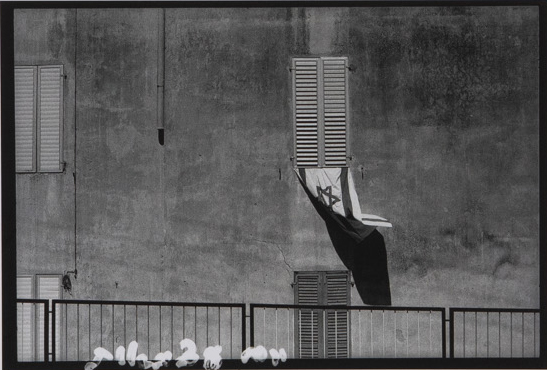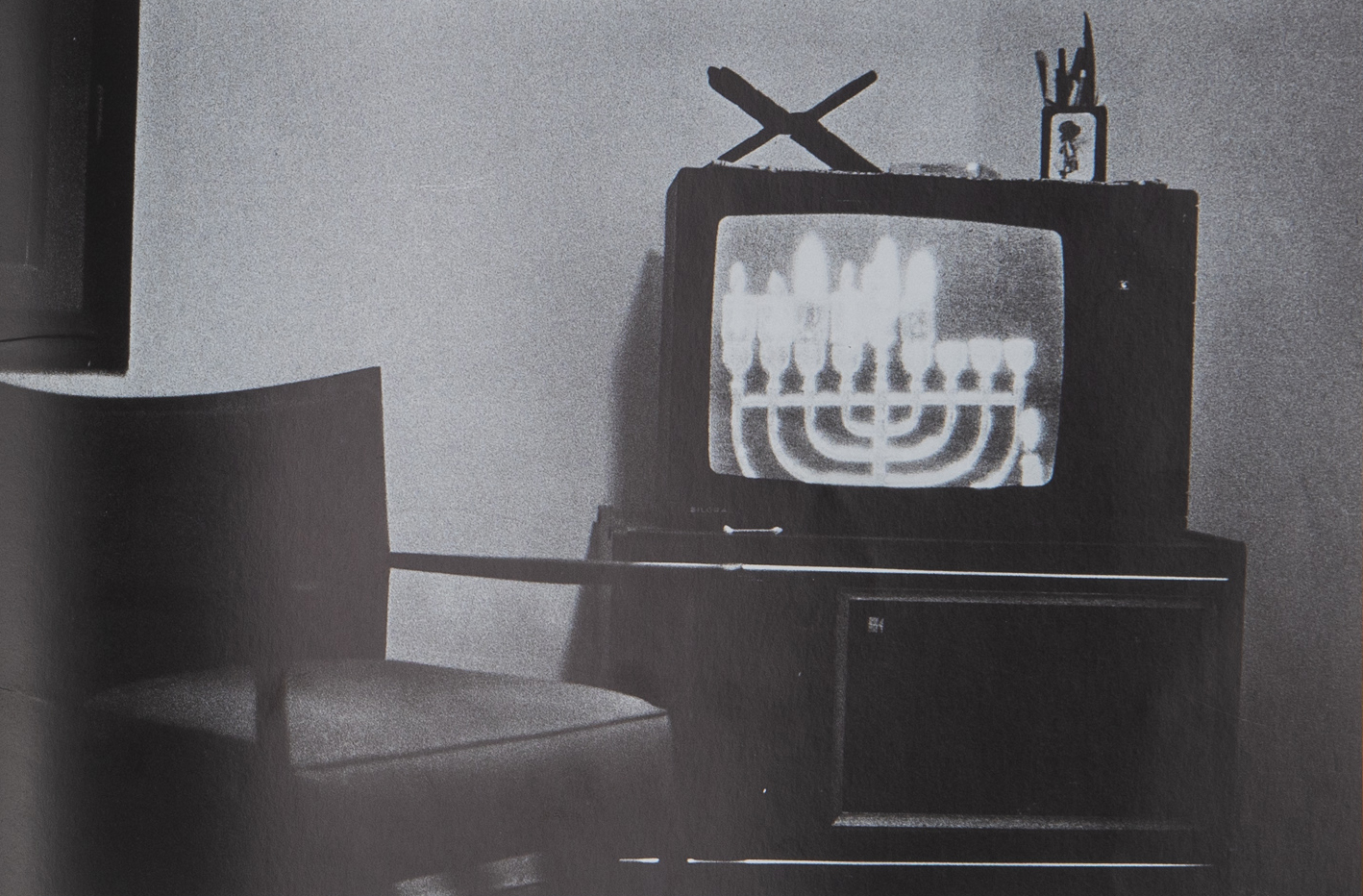
Over the past decade, I have been photographing the Israeli public space. The desire to get to know the society in which I live and better understand how the public space reflects it led me to initiate “Sojourn”: An ongoing independent residency project, which started in December 2015 and has no end date. As part of this platform, three times a year I travel to a place I have not been to, for a week. I find a contact that helps me get a modest place to stay and connects me with some local social activists. I schedule meetings with them over the first three days of my stay, learn about the place, and write a diary with quotes from these conversations. The rest of the time – I take pictures.
The goal is to stay in all types of communities, from all sectors. So far, I have stayed in sixteen townships: Arad, Kibbutz Bar’am, Ma’alot-Tarshiha, Mitzpe Ramon, Isfiya, Kibbutz Kfar Masaryk, Old Acre, Moshav Ma’ale Gamla, Shefar-Am, Moshav Timorim, Kfar Tavor, Eilat, Kibbutz Kfar Aaza, Metula, Efrat, and Jerusalem’s Katamonim neighborhood.
In 2020, I created an updated digital library on my website. Each residency has its own book, featuring quotes from my conversations with the local people I have met and my photographs. The quotes are an inseparable part of working on each residency. They are the voice of the local residents and serve as the documentary aspect of the piece. Its objective is to foreground the complexity of Israeli society, while the photos are my own personal impression of the place. It is the combination of the two that makes the whole.

Click on the image to see full website.
In March 2022 I stayed in Kibbutz Kfar Aza, and in November 2022 I stayed in Metula. The massacre that took place on October 7, 2023 and the evacuation of the residents from the south and the north of Israel, changed my perspective on life here, and my view on the journey I embarked on eight years ago. I knew people who were murdered in Kfar Aza, and I am keeping close contact with people who were evacuated from their homes. The events touched me deeply.
Today, when I read the quotes from the meetings with the residents in Kibbutz Kfar Aza and Metula, I recognize their fear from the rounds of fighting with Gaza, and the threat of Hezbollah. But I also see the love of the residents for their homes and the experience of living in a sort of paradise. The gap between these texts and the events that took place on October 7, 2023, makes these conversations, which took place two years ago, sound almost innocent. The horror and a tear between the state and its citizens is in this gap.
Looking at the photographs, which are only part of the "Sojourn" project, it is hard not to think of the two geographical ends, the north and the south, that are under consistent threat. In addition, it is possible to see two extreme viewpoints created by looking at them in the present: on the one hand, an almost nostalgic view is revealed of places that we can no longer experience as they were. They are now like beautiful postcards from the past. On the other hand, the absence of human presence in the photographs reflects the painful contemporary reality of abandoned places. A rift in time was created here, between the feeling that this is a distant past, and a wounded present that "skips" the time when I was present, stayed, and photographed in the place.

From 'Sojourn' by Nurit Yarden.
The following quotes were taken from conversations held with residents in Kibbutz Kfar Aza in 2022.
"Our kibbutz is big and strong, and we have a waiting list despite the risk of living here. Kfar Aza was built in 1957 by two Nahal groups (Gar'inim). The kibbutz has been privatized but has common economic sectors such as agriculture and the successful plant Kafrit, producing colors for the plastic industry. Most of the residents are kibbutz members, as many later joiners also became members."


"We are targeted quite often by fire from Gaza. The 'hosen center' (resilience center) opened, therefore, in Kibbutz Sha'ar HaNegev. The developed mental assistance array provides mental support to the region's inhabitants. When there is fire, I am afraid to be caught driving because we are completely exposed in the car. In the Gaza envelope, we drive with our eyes watching the sky. Some kibbutz members prefer living in less comfortable houses, provided that they don't face the fence and see Gaza. This may somewhat relieve their distress, but the danger to the kibbutz houses is the same, no matter where they are situated."


"We arrived at the kibbutz in 1985. At that time, we were able to visit Gaza and had connections with them. We drove to the Gaza beach, ate falafel, shopped, and Gaza residents worked in the kibbutz."
"In periods of combat, we also think about the Gaza children."


"Our kibbutz is not kibbutz-like. We have very few traditions that characterize other kibbutzim. We keep inventing new traditions, but they don't always persist."

"In 2000, when my son was born, shooting barrages began from Gaza. In the first years of the fire, we were in denial. Even after the first mortar bomb fell on us, we continued our lives. We didn't have shelters or "Red Color" early warning alerts. In 2008, when Jimmy [Kedoshim], a beloved kibbutz member was killed by a mortar bomb, our lives changed. His death shook us, and we instantly stopped denying the danger. Nowadays, when a military operation against Gaza is underway, families with children evacuate to safer places. Leaving home with the family is not simple every time, especially as we never know how long it will last. It creates a sense of rootlessness. But every time the families return to the kibbutz, we hold a large communal dinner for all the members."


[The young generation neighborhood].
"You should visit our new orchard. It is a fascinating place with many kinds of trees and flowers. It opened in 2020 after an incendiary kite from Gaza burned down the old orchard."

"As parents, the question of how damaging life here is to our children preoccupies us. After every fire period, we have asked the children if they wished to leave here and move to another place, and they always said they wanted to stay. The connections between children of all age groups in the kibbutz are very strong."


The following quotes were taken from conversations held with residents in Metula in 2022.
"Metula was founded in 1896 and I am the sixth generation living here. Our farm has undergone many transformations but today nobody wants to work in agriculture: it’s not worthwhile economically. Only large chains such as Rami Levy make a profit. Out of 120 farms that were in Metula previously, only 30 families are currently working in agriculture here."



"We came to Metula in 1973 for my work - but also because of Zionist feelings - to settle on the border."
"In 2000, when the IDF abruptly withdrew from Lebanon, a new population settled in Metula: families from the South Lebanon Army. About twelve of them are still living here. At first, Israel did not welcome them as they should have. They were Lebanese patriots, but they were regarded as collaborators. For the elderly, this remained an open wound: they were homesick. They would sit and look at Lebanon, their home, with binoculars. Their children and grandchildren have completely integrated into Metula."


"Whenever I can, I sit here and enjoy this wonderful view. The tempo of life is agreeable, and I love the quiet."
"About 700 students attending Tel Hai College rent apartments in Metula. Although this provides a good income for the residents, it doesn’t help the town flourish because these young people do not stay. We need young people to settle here as this town has gotten old."



"I’m not comfortable saying this but until 2000, when the IDF was still in Lebanon, Metula thrived economically. We were a transit station for our soldiers and the UN. The withdrawal from Lebanon was traumatic and from the moment the army withdrew, Metula started to decline. Previously, Lebanese rather than men from Thailand were our agricultural workers and their wives worked as housekeepers. They arrived in the morning, worked until 14:00 and then, for security reasons, had to return to Lebanon."

"The social status of the residents is determined by the amount of time they’ve been living here but those who don’t come from the founders' families are known as "foreigners" or "newcomers" even if they’ve lived here for 50 years."
"We’ve been living here for 21 years. We came to Metula from Kibbutz Malkia. We were twenty families' who moved together to Metula when the kibbutzim underwent privatization. Today, only six of these families have remained in Metula. When we first arrived here, we moved into new houses and the old-timers nicknamed our neighborhood 'Beverley Hills' although, as previous kibbutz members, we were far from rich."

"For me, Metula is my grandparents' home on Rishonim Street and the view of Lebanon. Look how close the fence is to us. You can see Lebanese cars driving on the road and I often try to imagine who those people are and where they’re going. We sometimes have the sensation of being in a an enclosure as we are surrounded by a border on three sides. I walk here every day and see the beauty on the other side of the fence, the Lebanon Hills and the Ayun Valley and know full well that I can’t go there."
Nurit Yarden, born in 1959, lives and works in Tel Aviv-Yafo. Yarden has a BFA from the Department of Photography, Bezalel Academy of Art and Design, Jerusalem. In her works, she combines direct photography with staged photography and deals with the tension between private and public spaces through visual, social, and political symbols. She recently had the solo exhibition: Sojourn - Katamonim at the New Gallery Artist's Studios Teddy in Jerusalem





